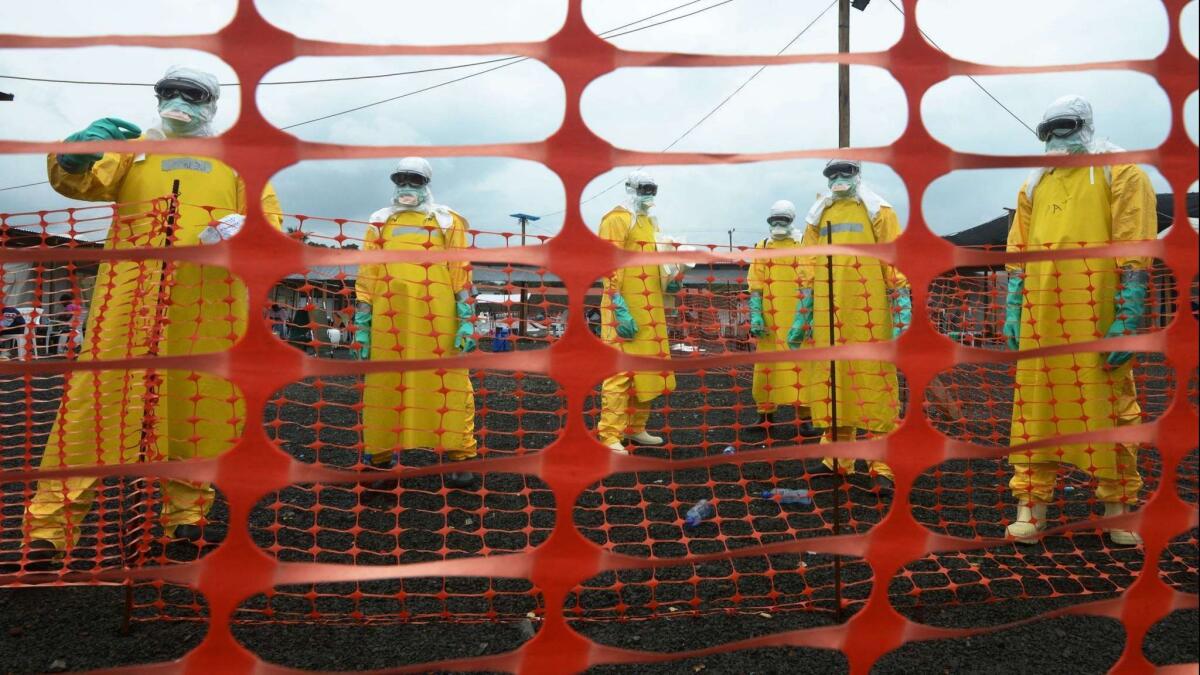Op-Ed: As the world warms, deadly and disfiguring tropical diseases are inching their way toward the U.S.

- Share via
Nearly 50 years ago, in the summer of 1969, Time magazine published photos of Cleveland’s Cuyahoga River in flames, searing the images into the national consciousness.
The Cuyahoga River on fire became a lasting symbol of environmental damage and pollution — and a tipping point that helped galvanize Americans to take action and Congress to enact landmark environmental legislation, including the Clean Water and Clean Air acts. Together, these laws save hundreds of thousands of American lives every year.
The recent National Climate Assessment paints a clear picture of the much larger environmental crisis that the United States confronts today: global warming. According to the report by 13 federal agencies, global warming will harm our ecosystems and our economy.
Destroying a forest can spark a pandemic.
Yet we continue to meet the rising temperatures, superstorms, drought and mega-fires caused by climate change with relative inaction.
Although the environmental costs of global warming may still seem distant to some Americans, there is a growing threat that many may find harder to ignore: infectious disease.
As another new report, the Lancet Countdown on Health and Climate Change, makes clear, warming poses a great diversity of risks for human health.
More and more, hot summers will increase mortality and limit our capacity for outdoor labor. Superstorms in some regions will cause flooding of sewage systems and thereby spread gastrointestinal disease, while severe droughts in other regions will increase rates of asthma. Food production will be severely reduced in many countries. Many regions will see increased risks of infection.
Although environmental destruction may not scare us in an immediate way, infectious diseases very well could. Indeed, the impacts on human health could become the burning river of the 21st century.
Let’s begin with Lyme disease. Forest destruction in the Northeast creates small wooded habitats where mammals that consume a variety of food can thrive while the diversity of other more specialized species plummets.
The white-footed mouse is one such generalist that abounds in tiny forests. Unfortunately, this mouse is poor at removing ticks but excellent at infecting them with Lyme disease. Meanwhile, small forests are missing the Virginia opossum, the so-called vacuum cleaner of the forest, which is able to remove and kill almost all the ticks it picks up.
Destroying a forest can also spark a pandemic. In West Africa, deforestation displaced bats from their forest habitat into villages such as Meliandou in southern Guinea. There, in 2013, a 2-year-old boy encountered a colony of bats in a hollow tree and contracted Ebola, a disease that would go on to claim his life and the lives of more than 11,000 other people.
As the world warms, tropical diseases are inching their way toward the United States. One such disease, leishmaniasis, marks its victims with crusty skin lesions and disfiguring scars. It has spread north from Mexico, through southern Texas and into Oklahoma.
Other tropical diseases that are being unleashed along with a warmer climate include elephantiasis, which causes a grotesque swelling of the limbs; Chagas disease, which can lead to severe chronic heart problems; and the Zika virus, with its attendant fetal brain disorders. All of these diseases are likely to move north.
Enter the Fray: First takes on the news of the minute from L.A. Times Opinion »
Infectious diseases will make visceral the toll that environmental destruction takes on human health, and in so doing may become a powerful motivator. In the past, humans have harnessed our fears of infection to improve public health — seeking cures, creating safe water supplies and discovering vaccines.
As a result of climate change, we will need to expand our concept of public health to include the broader environment. To protect the health of our own bodies, humans must also care for the natural world around us.
The fires on the Cuyahoga River were a watershed moment for environmental awareness in the United States. The leishmaniasis-scarred faces of Americans in the heartland may be the next.
Fred Cohan is a professor of biology and environmental studies at Wesleyan University in Connecticut. Isaac Klimasmith is a student at Wesleyan University and a Doris Duke conservation scholar.
Follow the Opinion section on Twitter @latimesopinion or Facebook.
More to Read
A cure for the common opinion
Get thought-provoking perspectives with our weekly newsletter.
You may occasionally receive promotional content from the Los Angeles Times.









